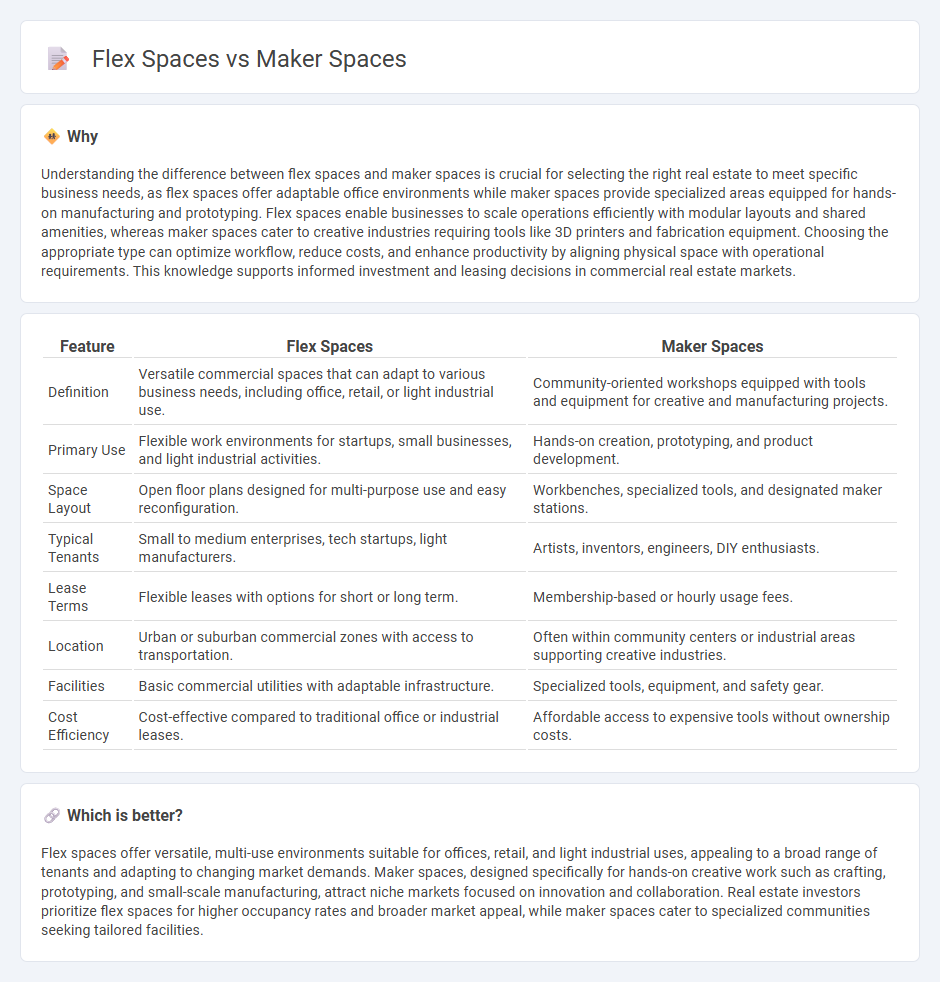
Flex spaces offer adaptable, multi-purpose environments catering to various business needs such as offices, retail, or light industrial use, while maker spaces focus on collaborative workshops equipped for creators, entrepreneurs, and artisans specializing in hands-on manufacturing and prototyping. Real estate investors and developers leverage flex spaces to maximize property utility and appeal to a broad tenant base, whereas maker spaces emphasize community engagement and innovation within creative industries. Explore how these distinct real estate concepts can shape your investment or operational strategy.
Why it is important
Understanding the difference between flex spaces and maker spaces is crucial for selecting the right real estate to meet specific business needs, as flex spaces offer adaptable office environments while maker spaces provide specialized areas equipped for hands-on manufacturing and prototyping. Flex spaces enable businesses to scale operations efficiently with modular layouts and shared amenities, whereas maker spaces cater to creative industries requiring tools like 3D printers and fabrication equipment. Choosing the appropriate type can optimize workflow, reduce costs, and enhance productivity by aligning physical space with operational requirements. This knowledge supports informed investment and leasing decisions in commercial real estate markets.
Comparison Table
| Feature | Flex Spaces | Maker Spaces |
|---|---|---|
| Definition | Versatile commercial spaces that can adapt to various business needs, including office, retail, or light industrial use. | Community-oriented workshops equipped with tools and equipment for creative and manufacturing projects. |
| Primary Use | Flexible work environments for startups, small businesses, and light industrial activities. | Hands-on creation, prototyping, and product development. |
| Space Layout | Open floor plans designed for multi-purpose use and easy reconfiguration. | Workbenches, specialized tools, and designated maker stations. |
| Typical Tenants | Small to medium enterprises, tech startups, light manufacturers. | Artists, inventors, engineers, DIY enthusiasts. |
| Lease Terms | Flexible leases with options for short or long term. | Membership-based or hourly usage fees. |
| Location | Urban or suburban commercial zones with access to transportation. | Often within community centers or industrial areas supporting creative industries. |
| Facilities | Basic commercial utilities with adaptable infrastructure. | Specialized tools, equipment, and safety gear. |
| Cost Efficiency | Cost-effective compared to traditional office or industrial leases. | Affordable access to expensive tools without ownership costs. |
Which is better?
Flex spaces offer versatile, multi-use environments suitable for offices, retail, and light industrial uses, appealing to a broad range of tenants and adapting to changing market demands. Maker spaces, designed specifically for hands-on creative work such as crafting, prototyping, and small-scale manufacturing, attract niche markets focused on innovation and collaboration. Real estate investors prioritize flex spaces for higher occupancy rates and broader market appeal, while maker spaces cater to specialized communities seeking tailored facilities.
Connection
Flex spaces and maker spaces intersect through their shared emphasis on adaptability and innovation within real estate environments, catering to evolving tenant needs. Flex spaces provide versatile layouts suitable for various industries, while maker spaces offer specialized zones equipped with tools and technology for creative production and prototyping. Both concepts drive demand in commercial real estate by fostering collaborative ecosystems that support startups, freelancers, and small businesses.
Key Terms
Zoning
Maker spaces often require zoning permits that accommodate manufacturing and light industrial activities due to their hands-on, production-oriented nature. Flex spaces are more versatile, typically zoned for mixed-use, allowing for offices, light industrial, or retail functions in one location. Explore zoning differences further to understand how they impact operational flexibility and compliance for each space type.
Lease Structure
Maker spaces typically offer short-term, flexible leases designed to accommodate artists and entrepreneurs who require access to specialized tools and collaborative environments. Flex spaces provide versatile lease structures that support both office and light industrial uses, often featuring scalable terms to suit growing businesses. Discover more about how lease structures impact workspace choices for your unique needs.
Build-out Customization
Maker spaces offer extensive build-out customization tailored to specific project needs, enabling users to design and modify work areas with specialized tools and equipment. Flex spaces provide adaptable environments with modular build-outs that can be reconfigured quickly for various business purposes, optimizing operational flexibility. Explore more to understand which solution best fits your customization requirements and project goals.
Source and External Links
Makerspace Overview - A makerspace is a collaborative workspace for making, learning, and sharing, often equipped with various tools like 3D printers and laser cutters.
Makerspaces K-12 - A makerspace is a collaborative environment that fosters creativity, innovation, and hands-on learning using a range of tools from low-tech to high-tech.
MakerSpace NYC - This is New York's largest community workspace, offering extensive classes and facilities for various crafts and technologies.
 dowidth.com
dowidth.com